|
|
OSM Tasking Manager Project Creation and AdministrationIf the user interface of the version you use looks different from the one described here then you should consult our version overview Section Index
The OpenStreetMap Tasking Manager is essential to conducting a mapathon, managing a HOT activation, or creating mapping tasks for student mappers. The Tasking Manager divides the work into manageable geographic chunks, which reduces editing conflicts, especially with large numbers of distributed mappers. The Tasking Manager also helps mapping accuracy and data quality by providing a consistent set of instructions for your mappers (e.g. ‘map all roads and buildings’). In short, the Tasking Manager is how you set up and direct the workflow for open mapping activities. This module describes the basic administration of the OSM Tasking Manager for successful mapping events. This guide is specifically written for those persons who need instructions on administration of the OSM Tasking Manager, including the creation and modification of mapping projects for open mapping events, i.e. ‘mapathons’. This guide is specifically applicable to instances of the OSM Tasking Manager version 3 including the HOT Tasking Manager and the TeachOSM Tasking Manager. The HOT or OSM Tasking Manager version 3 is frequently referred to as TM3, as a shorthand for Tasking Manager, version 3. Logging in & Access LevelsThe first thing to understand is access level. All access to TMd is authorized through the OpenStreetMap website. To access TM3 you will need an OpenStreetMap (OSM) account. Once you have this account visit the Tasking Manager and click Login to OpenStreetMap, which will refer you back to the OSM page where you can authorize the Tasking Manager to have limited access to your OSM account. Access Levels within the OSM Tasking ManagerThe OSM Tasking Manager has three user access levels:
You will need Project Manager Access level to create new projects using TM3. Initiate a new Project within TM3
Click your username in the upper right corner, then Create a New Project. You then may choose between drawing your area of interest (AoI) on the map, or importing an area of interest from a geojson file;
Draw an area of interest to be mapped
or Upload a GeoJSON or KML file of the area of interest to be mapped
Task CreationAn AoI for a project is the large overall area to map. That area is then divided up into smaller areas called Tasks. The AoI defined by the file upload or hand drawn will appear in the map frame, and you will then be asked to choose how the AoI is split into individual tasks. There are two options:
Using the Square Grid for task squaresTo create uniform square tiles, select the Square Grid option.
The AoI is automatically split into grid cells and each cell becomes a task. Determine the optimal tile size using the “Larger” and “Smaller” buttons to adjust the size of the Task squares. As such, a smaller tile size will result in more tasks. The optimal tile size will therefore depend both on the size of the area (create smaller tiles for a large project) and the number of features that will likely need to be mapped within each tile. Generally speaking, as the size of the AoI and/or the number of likely features increases, the tile size chosen for the project should decrease. Please note that there are multiple map layers available to use while determining Task square size. The button in the lower right corner of the map will provide your list of options for map layer. Choosing one of the imagery layers is probably the best option as it lets you see the actual imagery to be mapped. If you have custom imagery for the project, you can also load that in by using the button in the upper right of the map and putting in a TMS or WMS url. You can also create several different task sizes by using the “Split” tools. Task squares can be split multiple times. Again, using an imagery layer will help you decide where tasks need to be split. The “Reset” button will reset all of your split tasks. The Split (Polygon) option will let you draw a polygon over an area to create smaller tasks and the Split (Point) will let you click individual task squares to split. The Reset button will remove all of your custom splitting.
Considerations before deciding on tile sizes
After finalizing Task sizes, click “Next”. Arbitrary GeometriesIt is possible if you uploaded a file to define your project area, it could also contain information about the exact shapes you want your project’s individual tasks to be. If the AoI consists of one polygon, the project will have just one task. This is generally not needed and should only be needed for specific needs. Arbitrary geometries can not be split. Project Area TrimAfter determining the task sizes you will have the option to “Trim” your AoI. You can either trim the AoI to the exact polygon shape you drew or imported (suggested) or you can trim to the nearest task square that includes your AoI. After finalizing a the AoI trim, click “Next”. Create the projectGive the project a title (can be edited on the next screen) and click “Create” This establishes the project in the Tasking Manager and opens a screen where you can provide the descriptions, instructions and other information about the project. Keep in mind that this must not be underestimated. A fair share of mappers (in many cases the majority) will have no previous experience with OpenStreetMap and/or HOT and will thus not be familiar with tagging guidelines. It is very important that the objectives of the project are clear and that all resources which the mappers should take into account are laid out here. It is often advisable to confine one project to one class of objects to be mapped. If you need a basemap of an area better split it in several projects, one for the roads, one for the buildings etc. Now beginners can focus on a small class of objects while learning how to map them correctly. Otherwise you might end up with lots of tiles which contain a bit of everything but nothing really complete. Once the Project is created, you will need to edit all its associated settings:
Description
This screen allows you set the project priority, its status as Draft, Published, or Archived, a short description used in Project listings and the long description available once a mapper has selected the Project. Both the short and long description should provide information about why the project exists, who will use the data and the expected the impact the mapping will have. These fields support Markdown text and can include images and videos. Instructions
Entities to Map - A list of the features you want users to map. Generally the fewer features the better as they are more likely to get completed.
Changeset Comment - This is the default changeset comment that will be attached to every data upload to OSM. It usually includes something that identifies the Tasking Manager the project resides on and the features that were mapped. It is often used for “hash tags” to help identify the organization requesting and/or doing the mapping. It can also describe the mapping being done, e.g., “Mapping buildings.”
Detailed Instructions - This is where the majority of your detailed instructions will be placed and what we expect every mapper and validator to read carefully and follow. See the below notes on creating good instructions. Per Task Instructions - These will be displayed when a mapper selects a task and also has a special feature that allows Task specific URLs to be crafted based on the typical “slippy map” x, y, z coordinates. Metadata
Mapper Level - This is an indication of the difficulty of the mapping project. There are 3 options Beginner, Intermediate and Advanced. This setting is an indication to the mapper what experience level they should have to be most successful in mapping the project. It can be used in project list filtering and the suggested level can be required in the Permissions screen. Type of Mapping - Used in project list filtering and helps mappers find projects they like to map. **Organization **- Allows you to specify the organization the mapping will be used by. Used in project filtering. **Campaign **- This allows you to group the project with other projects that are part of larger overall mapping effort. Used in project list filtering. Priority Areas
Use the provided tools to draw areas that should be mapped first. You can have multiple priority areas for a Project. You can also change priority areas at any time.
ImageryURL Field - A field that takes a TMS URL that will passed automatically to the OSM Editor the mapper or validator uses. Please follow the example, it is very important it is formatted correctly to work in all editors. License - Optionally, if there is a specific license required for the mapper to accept in using the imagery, you can select it here. If you need a licese that is not available, you can contact an administrator for the Tasking Manager installation and ask them to add it. Permissions
Mapper Level - Allows you to require that a mapper is at the proper level to map on the project (Metadata screen above). Mapper levels can be set manually, but are automatically applied based on total changesets. Require Validator Role - This allows you to require that people doing validation have been evaluated to be qualified validators. It is a peer review process to designate someone a Validator, Project Managers and existing Validators can mark any user as a qualified Validator. Private Project - This restricts access to the Project to a list of Users. Users must have logged into the Tasking Manager at least once before they can be added to a project. SettingsDefault Locale - Allows the setting of default instructions language for a project. Actions
Message All Contributors - Sends a Tasking Manager message to everyone who has marked a task complete or valid. It can be used to thank contributors and/or guide them to other projects in a portfolio/campaign. It should also be used before using either of the two Validate/Invalidate all Tasks options described below. Validate all Tasks - This will mark all tasks to “Green” validated status, with the exception of tasks that have been marked as “Bad Imagery” Invalidate all Tasks - This will mark all tasks to “Red” invalidated status, with the exception of tasks that have been marked as “Bad Imagery” Delete Project - This will permanently delete the project from the Tasking Manager. Clone Project - This will create a duplicate of the project except for the AoI which you will need to re-import or re-draw. Instruction NotesPlease use plain language as your target audience may not consist of native English speakers.
Considerations concerning ImageryIn most cases we use the “standard” Bing imagery. But there are situations where you might want to choose an alternative source:
If Bing does not prove adequate then Mapbox is the next choice. You should only look for other sources if neither of these two meet your requirements. In such cases it is not sufficient to choose a license-compatible source and make it available through a WMS or TMS service. Your AoI has probably already been partially mapped using Bing or Mapbox imagery and there might be a noticeable offset between images. You must have a close look at various locations of your AoI and determine the offset between your imagery and previously mapped data. If the existing OSM data are offset with respect to your imagery but fit Bing imagery then we usually assume that Bing is the “gold standard” unless we have GPS traces which prove that this assumption is wrong. If there is a constant offset between your imagery and Bing across the AoI then this might be corrected on the server so that images from various sources loaded in the editor match. If this is not possible, if the offset varies across the AoI or if existing data are aligned with various sources then it is time for plan B: The important point is that you must develop a strategy for how to cope with these issues and provide detailed instructions to mappers and validators. We strongly suggest that you declare such a project “for experienced mappers only” and explain that experience in this case does not mean having mapped 200+ buildings but having already dealt with alignment issues and different imagery sources. One possible strategy could include these steps:
It is important that step 3 is repeated for every task of the project and the individual task squares should not be too large because imagery offsets can vary considerably across an AoI, particularly if the terrain is not flat. Even imagery discontinuities may occur across a project - look out for them and advise the contributors of such a problem. Here are some suggested bits of information which you might include in the project instructions:
Proofread and PublishProofread the various tabs to ensure wording and formatting are correct, and instructions are clear. If you need to make changes or refinements to your project, click the ‘Edit’ link in the upper right hand corner of the page. If the project is ready for mapping, click the ‘Publish’ link. Once the project is published, it is available for mapping to anyone with an OSM account, unless a group of users was specified in the ‘Allowed Users’ tab, in which case only the allowed users would be able to work on it. If necessary, edits can still be made to the project after publication by clicking on the ‘Edit’ link.
Was this chapter helpful?
Let us know and help us improve the guides!
|

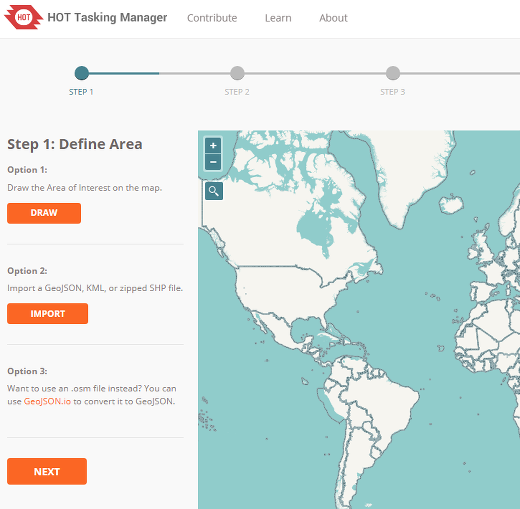

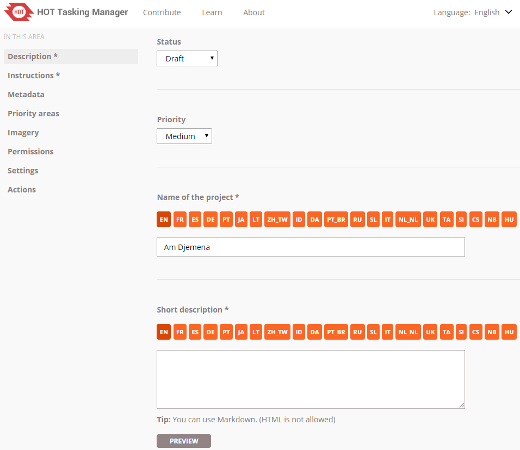
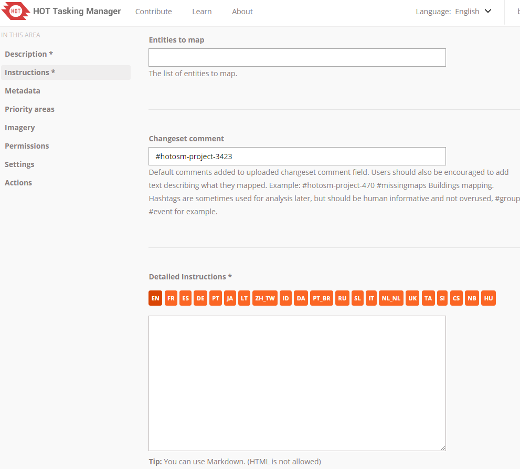
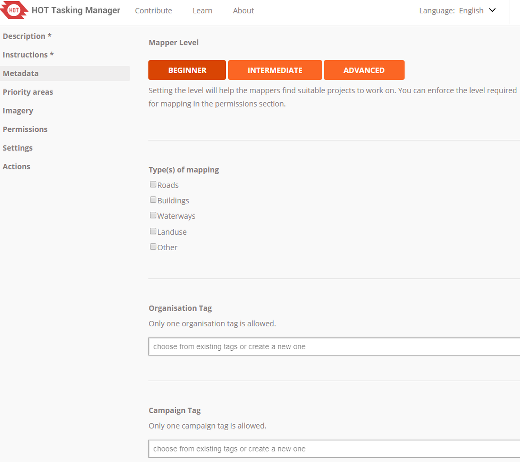
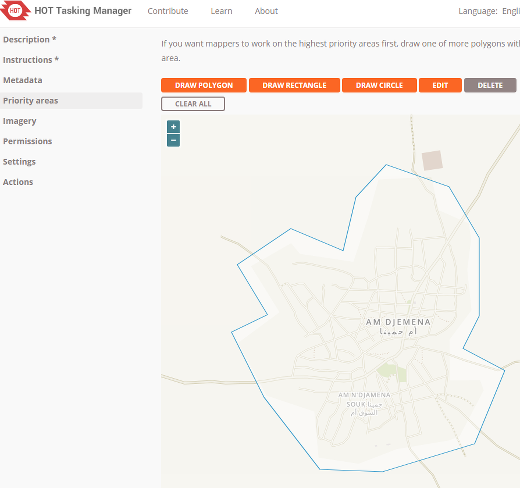
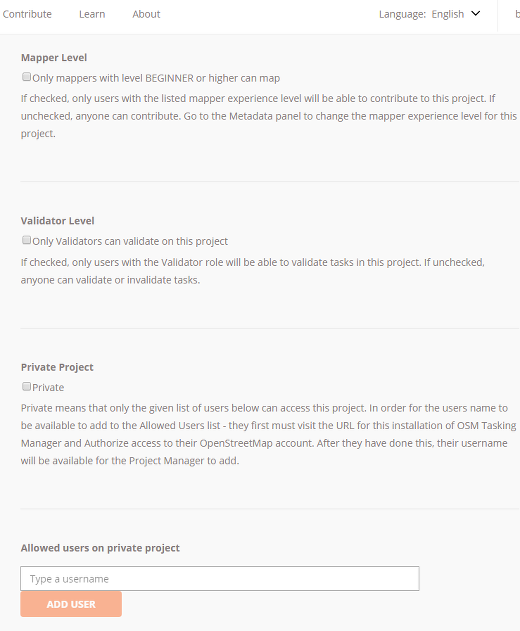
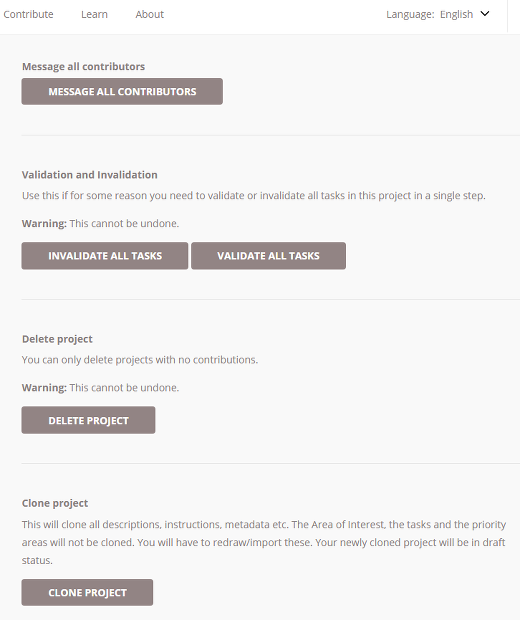
 Return to top of page
Return to top of page